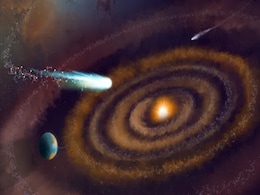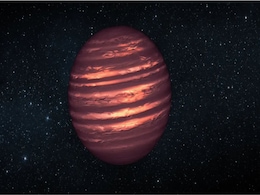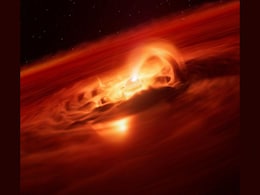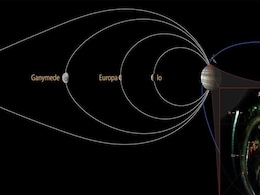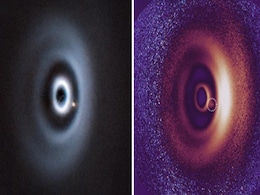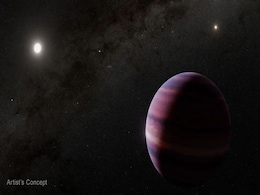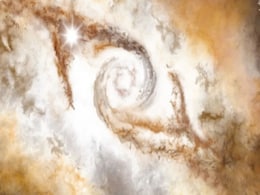Gas Discovery
- All
- News
- Videos
-

Webb Finds Phosphorus-Bearing Gas in an Ancient Brown Dwarf
- Monday November 10, 2025
- Written by Gadgets 360 Staff
NASA’s James Webb Space Telescope has detected phosphine (PH₃) in the atmosphere of the ancient brown dwarf Wolf 1130C, about 54 light-years away in Cygnus. This marks the first confirmed detection of a phosphorus-bearing gas in such a metal-poor object. The finding surprises astronomers, as phosphine was previously undetected in similar brown ...
-
 www.gadgets360.com
www.gadgets360.com
-

NASA's James Webb Space Telescope Telescope Challenges Old Theories on Mini-Neptune Worlds
- Friday November 7, 2025
- Written by Gadgets 360 Staff
New models suggest mini-Neptunes—planets smaller than Neptune with thick gas envelopes—may have solid rocky surfaces instead of molten magma. Data from NASA’s JWST revealed high-pressure atmospheres capable of compressing molten rock into solid crusts. This discovery challenges earlier assumptions and offers key insights into exoplanet compos...
-
 www.gadgets360.com
www.gadgets360.com
-

Food Waste To Flight: Scientists Make Sustainable Aviation Fuel A Reality
- Saturday November 1, 2025
- Science | Edited by Astitva Raj
This discovery is considered a significant step toward cleaner air travel by converting large-scale waste into high-quality jet fuel.
-
 www.ndtv.com
www.ndtv.com
-

Astronomers Detect Heavy Water in Planet-Forming Disk Around Young Star
- Monday October 20, 2025
- Written by Gadgets 360 Staff
Scientists have detected heavy water in the planet-forming disk around young star V883 Orionis, confirming the water existed long before the star formed. The discovery, made using ALMA, shows that water’s origins trace back to ancient interstellar clouds, linking molecular gas, comets, and planetary systems across billions of years.
-
 www.gadgets360.com
www.gadgets360.com
-

James Webb Space Telescope Detects Phosphine on Brown Dwarf Wolf 1130C
- Thursday October 9, 2025
- Written by Gadgets 360 Staff
Using the James Webb Space Telescope, scientists have detected phosphine gas in the atmosphere of the brown dwarf Wolf 1130C, about 54 light-years away. The finding suggests phosphine can form in extreme, non-biological environments, challenging its status as a potential biomarker and reshaping how scientists search for alien life.
-
 www.gadgets360.com
www.gadgets360.com
-

Astronomers Capture First-Ever Image Of A Baby Planet Forming In Real Time
- Tuesday October 7, 2025
- Science | Edited by Nikhil Pandey
Astronomers have made a groundbreaking discovery by directly observing a young protoplanet, WISPIT 2b, embedded in a ring-shaped gap in a disk around a young star.
-
 www.ndtv.com
www.ndtv.com
-

Astronomers Spot Rapidly Growing Rogue Planet Feeding on Surrounding Gas
- Sunday October 5, 2025
- Written by Gadgets 360 Staff
Astronomers have discovered that Cha 1107-7626, a rogue planet 620 light-years away, is now the fastest-growing planet ever observed. The massive world consumes six billion tonnes of gas per second, a rate never before recorded. The findings suggest rogue planets can grow in star-like ways, reshaping how scientists view free-floating planetary obje...
-
 www.gadgets360.com
www.gadgets360.com
-

NASA’s James Webb Telescope May Have Found First Black Hole Star, Known as ‘The Cliff’
- Thursday September 25, 2025
- Written by Gadgets 360 Staff
JWST detected “The Cliff,” a candidate black hole star with a black hole core wrapped in a luminous gas shell. This discovery offers insights into black hole formation, stellar evolution, and cosmic dynamics, prompting astronomers to search for similar objects across the universe.
-
 www.gadgets360.com
www.gadgets360.com
-

NASA’s Chandra Finds Black Hole Growing Beyond Known Limits
- Sunday September 28, 2025
- Written by Gadgets 360 Staff
A black hole in quasar RACS J0320-35, 12.8 billion light-years away, is growing 2.4 times faster than theory permits. Chandra’s discovery challenges ideas of how supermassive black holes formed so soon after the Big Bang.
-
 www.gadgets360.com
www.gadgets360.com
-

Universe’s First Stars May Have Been Smaller Than Astronomers Once Believed
- Tuesday September 9, 2025
- Written by Gadgets 360 Staff
Astronomers once thought the universe’s first stars were only massive giants. New simulations and lab experiments reveal turbulence and early chemistry allowed smaller, Sun-like stars to form too. This discovery reshapes our view of cosmic dawn, showing the first stellar generation was more diverse than previously believed.
-
 www.gadgets360.com
www.gadgets360.com
-

NASA’s Juno Spacecraft Detects Callisto’s Aurora, Completing Jupiter’s Galilean Moons Set
- Wednesday September 3, 2025
- Written by Gadgets 360 Staff
NASA’s Juno spacecraft has captured Callisto’s elusive auroral footprint, completing the “family portrait” of Jupiter’s Galilean moons. Each moon carves its own aurora into the gas giant’s poles, revealing how they interact with Jupiter’s powerful magnetosphere. Callisto’s faint arc appeared during a 2019 flyby, finally confirming i...
-
 www.gadgets360.com
www.gadgets360.com
-

Astronomers Discover Calvera, a Runaway Pulsar Racing Above the Milky Way
- Wednesday September 3, 2025
- Written by Gadgets 360 Staff
Astronomers have discovered Calvera, a pulsar speeding 6,500 light-years above the Milky Way’s disk. Formed from a supernova in a nearly empty region, Calvera challenges long-held ideas of star birth and death. Its discovery reveals that extreme stellar events can occur even in the galaxy’s sparse outer halo.
-
 www.gadgets360.com
www.gadgets360.com
-

A Planet Is Being Born: Astronomers Capture Rare Cosmic Snapshot
- Saturday August 30, 2025
- Written by Gadgets 360 Staff
Astronomers have captured a groundbreaking sight: WISPIT 2b, a baby gas giant planet forming within a dusty, multi-ring protoplanetary disk around a young Sun-like star 430 light-years away. Infrared images from the Very Large Telescope show the planet carving a dark path in the rings as it feeds on gas and dust. This rare discovery provides the fi...
-
 www.gadgets360.com
www.gadgets360.com
-

James Webb Telescope Detects Potential Gas Giant Exoplanet Just 4 Light-Years Away
- Friday August 8, 2025
- Written by Gadgets 360 Staff
Astronomers using JWST have spotted a possible gas giant orbiting Alpha Centauri A, only 4 light-years away. If confirmed, it would be the closest exoplanet to a Sun-like star ever imaged. The discovery could challenge current models of planetary formation in binary systems and open new opportunities for studying nearby worlds.
-
 www.gadgets360.com
www.gadgets360.com
-

Massive 200-Light-Year Cloud May Be Channeling Matter to the Milky Way's Core
- Saturday August 2, 2025
- Written by Gadgets 360 Staff
Astronomers have discovered a massive, 200-light-year-wide cloud of gas and dust—dubbed the Midpoint cloud—hidden in the Milky Way. This giant molecular cloud appears to channel dense material into the galaxy’s core, possibly fueling star formation. The discovery offers rare insights into how matter flows from the galaxy’s disk to its turbu...
-
 www.gadgets360.com
www.gadgets360.com
-

Webb Finds Phosphorus-Bearing Gas in an Ancient Brown Dwarf
- Monday November 10, 2025
- Written by Gadgets 360 Staff
NASA’s James Webb Space Telescope has detected phosphine (PH₃) in the atmosphere of the ancient brown dwarf Wolf 1130C, about 54 light-years away in Cygnus. This marks the first confirmed detection of a phosphorus-bearing gas in such a metal-poor object. The finding surprises astronomers, as phosphine was previously undetected in similar brown ...
-
 www.gadgets360.com
www.gadgets360.com
-

NASA's James Webb Space Telescope Telescope Challenges Old Theories on Mini-Neptune Worlds
- Friday November 7, 2025
- Written by Gadgets 360 Staff
New models suggest mini-Neptunes—planets smaller than Neptune with thick gas envelopes—may have solid rocky surfaces instead of molten magma. Data from NASA’s JWST revealed high-pressure atmospheres capable of compressing molten rock into solid crusts. This discovery challenges earlier assumptions and offers key insights into exoplanet compos...
-
 www.gadgets360.com
www.gadgets360.com
-

Food Waste To Flight: Scientists Make Sustainable Aviation Fuel A Reality
- Saturday November 1, 2025
- Science | Edited by Astitva Raj
This discovery is considered a significant step toward cleaner air travel by converting large-scale waste into high-quality jet fuel.
-
 www.ndtv.com
www.ndtv.com
-

Astronomers Detect Heavy Water in Planet-Forming Disk Around Young Star
- Monday October 20, 2025
- Written by Gadgets 360 Staff
Scientists have detected heavy water in the planet-forming disk around young star V883 Orionis, confirming the water existed long before the star formed. The discovery, made using ALMA, shows that water’s origins trace back to ancient interstellar clouds, linking molecular gas, comets, and planetary systems across billions of years.
-
 www.gadgets360.com
www.gadgets360.com
-

James Webb Space Telescope Detects Phosphine on Brown Dwarf Wolf 1130C
- Thursday October 9, 2025
- Written by Gadgets 360 Staff
Using the James Webb Space Telescope, scientists have detected phosphine gas in the atmosphere of the brown dwarf Wolf 1130C, about 54 light-years away. The finding suggests phosphine can form in extreme, non-biological environments, challenging its status as a potential biomarker and reshaping how scientists search for alien life.
-
 www.gadgets360.com
www.gadgets360.com
-

Astronomers Capture First-Ever Image Of A Baby Planet Forming In Real Time
- Tuesday October 7, 2025
- Science | Edited by Nikhil Pandey
Astronomers have made a groundbreaking discovery by directly observing a young protoplanet, WISPIT 2b, embedded in a ring-shaped gap in a disk around a young star.
-
 www.ndtv.com
www.ndtv.com
-

Astronomers Spot Rapidly Growing Rogue Planet Feeding on Surrounding Gas
- Sunday October 5, 2025
- Written by Gadgets 360 Staff
Astronomers have discovered that Cha 1107-7626, a rogue planet 620 light-years away, is now the fastest-growing planet ever observed. The massive world consumes six billion tonnes of gas per second, a rate never before recorded. The findings suggest rogue planets can grow in star-like ways, reshaping how scientists view free-floating planetary obje...
-
 www.gadgets360.com
www.gadgets360.com
-

NASA’s James Webb Telescope May Have Found First Black Hole Star, Known as ‘The Cliff’
- Thursday September 25, 2025
- Written by Gadgets 360 Staff
JWST detected “The Cliff,” a candidate black hole star with a black hole core wrapped in a luminous gas shell. This discovery offers insights into black hole formation, stellar evolution, and cosmic dynamics, prompting astronomers to search for similar objects across the universe.
-
 www.gadgets360.com
www.gadgets360.com
-

NASA’s Chandra Finds Black Hole Growing Beyond Known Limits
- Sunday September 28, 2025
- Written by Gadgets 360 Staff
A black hole in quasar RACS J0320-35, 12.8 billion light-years away, is growing 2.4 times faster than theory permits. Chandra’s discovery challenges ideas of how supermassive black holes formed so soon after the Big Bang.
-
 www.gadgets360.com
www.gadgets360.com
-

Universe’s First Stars May Have Been Smaller Than Astronomers Once Believed
- Tuesday September 9, 2025
- Written by Gadgets 360 Staff
Astronomers once thought the universe’s first stars were only massive giants. New simulations and lab experiments reveal turbulence and early chemistry allowed smaller, Sun-like stars to form too. This discovery reshapes our view of cosmic dawn, showing the first stellar generation was more diverse than previously believed.
-
 www.gadgets360.com
www.gadgets360.com
-

NASA’s Juno Spacecraft Detects Callisto’s Aurora, Completing Jupiter’s Galilean Moons Set
- Wednesday September 3, 2025
- Written by Gadgets 360 Staff
NASA’s Juno spacecraft has captured Callisto’s elusive auroral footprint, completing the “family portrait” of Jupiter’s Galilean moons. Each moon carves its own aurora into the gas giant’s poles, revealing how they interact with Jupiter’s powerful magnetosphere. Callisto’s faint arc appeared during a 2019 flyby, finally confirming i...
-
 www.gadgets360.com
www.gadgets360.com
-

Astronomers Discover Calvera, a Runaway Pulsar Racing Above the Milky Way
- Wednesday September 3, 2025
- Written by Gadgets 360 Staff
Astronomers have discovered Calvera, a pulsar speeding 6,500 light-years above the Milky Way’s disk. Formed from a supernova in a nearly empty region, Calvera challenges long-held ideas of star birth and death. Its discovery reveals that extreme stellar events can occur even in the galaxy’s sparse outer halo.
-
 www.gadgets360.com
www.gadgets360.com
-

A Planet Is Being Born: Astronomers Capture Rare Cosmic Snapshot
- Saturday August 30, 2025
- Written by Gadgets 360 Staff
Astronomers have captured a groundbreaking sight: WISPIT 2b, a baby gas giant planet forming within a dusty, multi-ring protoplanetary disk around a young Sun-like star 430 light-years away. Infrared images from the Very Large Telescope show the planet carving a dark path in the rings as it feeds on gas and dust. This rare discovery provides the fi...
-
 www.gadgets360.com
www.gadgets360.com
-

James Webb Telescope Detects Potential Gas Giant Exoplanet Just 4 Light-Years Away
- Friday August 8, 2025
- Written by Gadgets 360 Staff
Astronomers using JWST have spotted a possible gas giant orbiting Alpha Centauri A, only 4 light-years away. If confirmed, it would be the closest exoplanet to a Sun-like star ever imaged. The discovery could challenge current models of planetary formation in binary systems and open new opportunities for studying nearby worlds.
-
 www.gadgets360.com
www.gadgets360.com
-

Massive 200-Light-Year Cloud May Be Channeling Matter to the Milky Way's Core
- Saturday August 2, 2025
- Written by Gadgets 360 Staff
Astronomers have discovered a massive, 200-light-year-wide cloud of gas and dust—dubbed the Midpoint cloud—hidden in the Milky Way. This giant molecular cloud appears to channel dense material into the galaxy’s core, possibly fueling star formation. The discovery offers rare insights into how matter flows from the galaxy’s disk to its turbu...
-
 www.gadgets360.com
www.gadgets360.com




